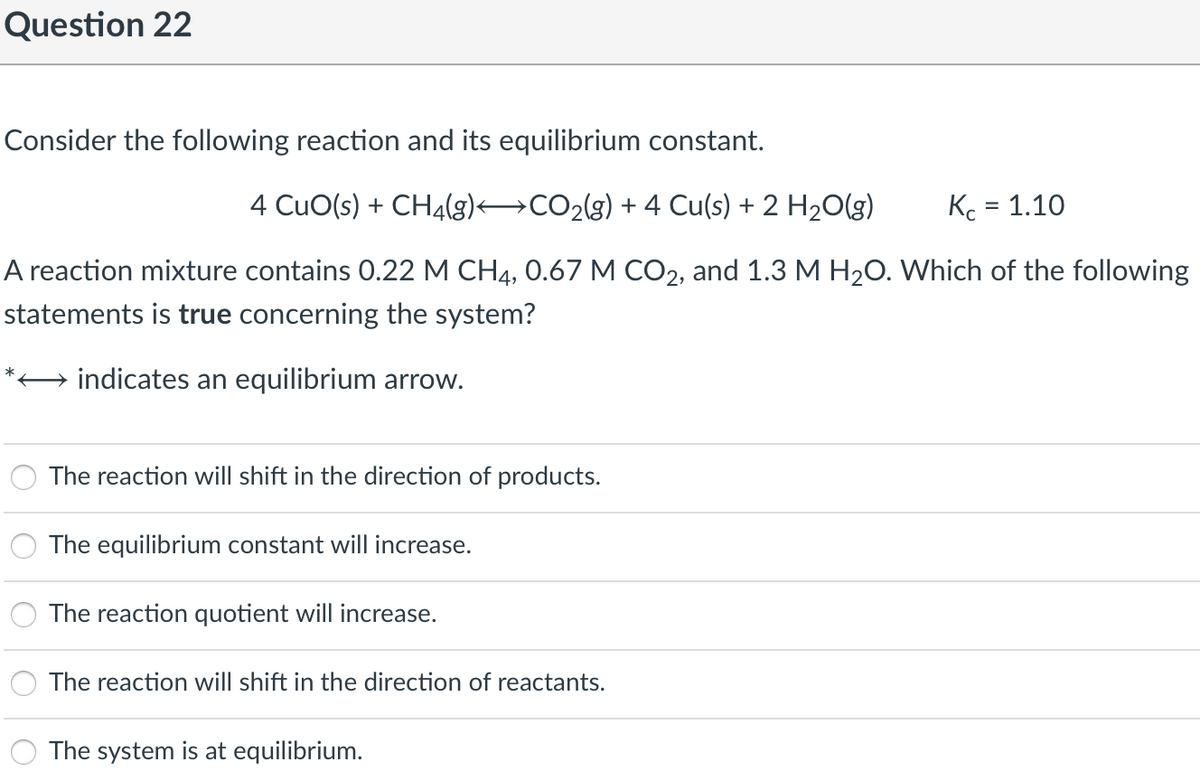Consider the following reaction and its equilibrium constant. 4 CuO(s) + CH4(g) CO2(g) + 4 Cu(s) + 2 H2O(g) Kc = 1.10 A reaction mixture contains 0.22 M CH4, 0.67 M CO2, and 1.3 M H2O. Which of the following statements is true concerning the system? + indicates an equilibrium arrow. The reaction will shift in the direction of products. The equilibrium constant will increase. The reaction quotient will increase. The reaction will shift in the direction of reactants. The system is at equilibrium.
Consider the following reaction and its equilibrium constant. 4 CuO(s) + CH4(g) CO2(g) + 4 Cu(s) + 2 H2O(g) Kc = 1.10 A reaction mixture contains 0.22 M CH4, 0.67 M CO2, and 1.3 M H2O. Which of the following statements is true concerning the system? + indicates an equilibrium arrow. The reaction will shift in the direction of products. The equilibrium constant will increase. The reaction quotient will increase. The reaction will shift in the direction of reactants. The system is at equilibrium.
Chemistry: Principles and Practice
3rd Edition
ISBN:9780534420123
Author:Daniel L. Reger, Scott R. Goode, David W. Ball, Edward Mercer
Publisher:Daniel L. Reger, Scott R. Goode, David W. Ball, Edward Mercer
Chapter14: Chemical Equilibrium
Section: Chapter Questions
Problem 14.95QE: Nitrogen, hydrogen, and ammonia are in equilibrium in a 1000-L reactor at 550 K. The concentration...
Related questions
Question

Transcribed Image Text:Question 22
Consider the following reaction and its equilibrium constant.
4 CuO(s) + CH4(g) CO2(g) + 4 Cu(s) + 2 H20(g)
Kc = 1.10
A reaction mixture contains 0.22 M CH4, 0.67 M CO2, and 1.3 M H20. Which of the following
statements is true concerning the system?
indicates an equilibrium arrow.
The reaction will shift in the direction of products.
The equilibrium constant will increase.
The reaction quotient will increase.
The reaction will shift in the direction of reactants.
The system is at equilibrium.
Expert Solution
This question has been solved!
Explore an expertly crafted, step-by-step solution for a thorough understanding of key concepts.
This is a popular solution!
Trending now
This is a popular solution!
Step by step
Solved in 3 steps

Knowledge Booster
Learn more about
Need a deep-dive on the concept behind this application? Look no further. Learn more about this topic, chemistry and related others by exploring similar questions and additional content below.Recommended textbooks for you

Chemistry: Principles and Practice
Chemistry
ISBN:
9780534420123
Author:
Daniel L. Reger, Scott R. Goode, David W. Ball, Edward Mercer
Publisher:
Cengage Learning

Chemistry for Engineering Students
Chemistry
ISBN:
9781337398909
Author:
Lawrence S. Brown, Tom Holme
Publisher:
Cengage Learning

Chemistry & Chemical Reactivity
Chemistry
ISBN:
9781133949640
Author:
John C. Kotz, Paul M. Treichel, John Townsend, David Treichel
Publisher:
Cengage Learning

Chemistry: Principles and Practice
Chemistry
ISBN:
9780534420123
Author:
Daniel L. Reger, Scott R. Goode, David W. Ball, Edward Mercer
Publisher:
Cengage Learning

Chemistry for Engineering Students
Chemistry
ISBN:
9781337398909
Author:
Lawrence S. Brown, Tom Holme
Publisher:
Cengage Learning

Chemistry & Chemical Reactivity
Chemistry
ISBN:
9781133949640
Author:
John C. Kotz, Paul M. Treichel, John Townsend, David Treichel
Publisher:
Cengage Learning

Chemistry & Chemical Reactivity
Chemistry
ISBN:
9781337399074
Author:
John C. Kotz, Paul M. Treichel, John Townsend, David Treichel
Publisher:
Cengage Learning

Chemistry
Chemistry
ISBN:
9781305957404
Author:
Steven S. Zumdahl, Susan A. Zumdahl, Donald J. DeCoste
Publisher:
Cengage Learning
